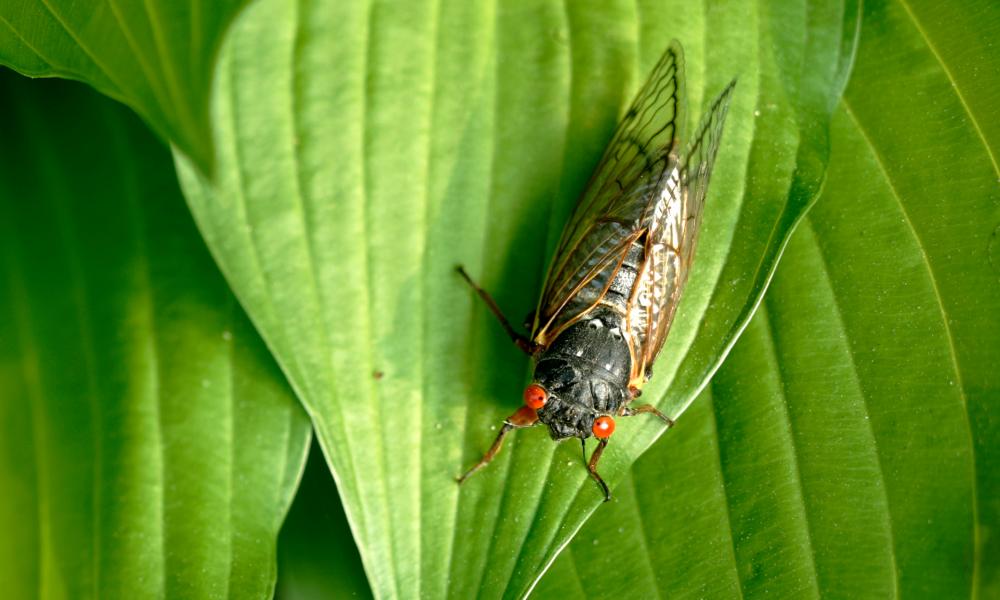The cicadas are arriving. The periodic emergence of trillions of cicadas, on a scale not seen in several hundred years, is under way in parts of the US, with several states reporting the orange-eyed insects are bursting from their underground dormancy.
Cicadas have started arriving earlier than expected in Illinois, a cicada hotspot this year, while there are reports of swarms emerging in Georgia, North Carolina and Tennessee, along with some other states.
In South Carolina, the noise emitted by male cicadas calling for potential mates has prompted some people to call the police asking why they can hear sounds “like a siren, or a whine, or a roar”. One resident said that the sound given off resembled “somebody screaming”.
The emergence is the largest such event since 1803, with trillions of cicadas coming above-ground at once across much of the midwestern and eastern US. The simultaneous appearance of two cicada broods – known as Brood XIX and Brood XIII – is a rare event that has caused wonder and excitement among researchers and some members of the public, as well as calls of alarm to the police.
Here’s what you need to know about what is being called “cicada-geddon” or “cicada-palooza”.
When and where are the cicadas emerging?
Cicadas have already started to appear in several states, with many more expected in the coming weeks as soils reach the optimum temperature of about 64F (17C). This huge burst of life is expected to be visible and raucous but brief, with the cicadas emerging, reproducing and dying, if they avoid being devoured by predators, within six weeks.
The offspring they produce will then grow underground until the next emergence, starting the cycle all over again. This process should all be finished by June or July.
Do cicadas really sleep for 17 years?
Not all cicadas are what as known as “periodical”, which means a lifespan involving development underground, sucking on plant sap before emerging on schedule after a certain number of years.
But of the seven periodical cicada species in the US, three – named Magicicada septendecim, Magicicada cassini and Magicicada septendecula – spend 17 years underground. A further four species – Magicicada tredecim, Magicicada neotredecim, Magicicada tredecassini, and Magicicada tredecula – are on a 13-year cycle.
This year will see Brood XIX, the largest of all periodical cicada groups, emerge after a 13-year dormancy underground at the same time as Brood XIII, a smaller group that appears every 17 years.
While underground, the cicadas aren’t hibernating. As wingless juveniles, they are conscious, burrowing tunnels for themselves and feeding on sap from tree roots.
What is a ‘zombie’ cicada?
Some, but far from all, of the cicadas emerging this year will be so-called “zombie” cicadas. These insects have been infected by a sexually transmitted fungus that makes them hyper-sexual.
Once spores of the fungus come into contact with the cicadas, the insects’ bodies are hijacked by the fungal parasite. A large mass of fungal spores builds up in the abdomen of infected cicadas causing the back end of the animals, including its genitals, to fall off. Despite this, the infected cicadas still attempt to mate in a frenzied way, as a way to spread the fungus, often with disastrous results for would-be partners.
“Periodical cicadas have interlocking genitalia. So when they pull apart, guess what happens? Rip. And then there’s a cicada walking around with someone else’s genitals stuck to them,” said John Cooley, a cicada expert at the University of Connecticut.
What should I do when there are trillions of cicadas around?
Some people’s thoughts have turned to food – a Chicago-area bakery has started making cicada-shaped cakes, while some chefs have provided tips on how to eat the cicadas themselves.
But for others there is a deeper resonance to the spectacle. “I like to remind people that this is a natural wonder of the world. You just don’t see this biomass of terrestrial life anywhere else,” said Catherine Dana, an entomologist at the University of Illinois at Urbana-Champaign.
The appearance of cicadas on such a scale is certainly not an everyday occurrence – it hasn’t happened since Thomas Jefferson was US president. The cicadas stick to their routine, even as the world rapidly changes around them.
“Sit back and be in awe at the spectacle,” advised Cooley. “It will be over soon enough. Then think about where you will be in 13 or 17 years. It’s a time for introspection.”
OK, but are cicadas dangerous to me?
No. Some insect-phobic people are currently wondering whether they should flee the onslaught. Cicadas aren’t harmful to people or pets in any way, though, with the insects having a straw-like mouth rather than any sort of biting parts. They don’t sting, either. Scientists say people shouldn’t douse them with chemicals as if they were some sort of pest.
Some cicadas have been found to expel jets of urine when threatened, however.
